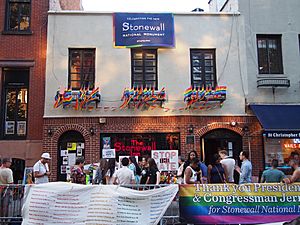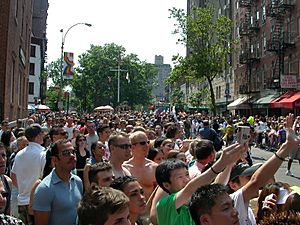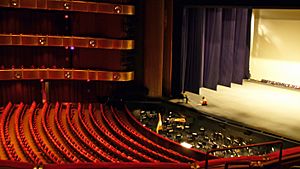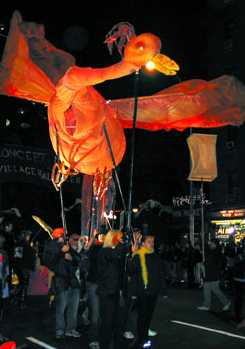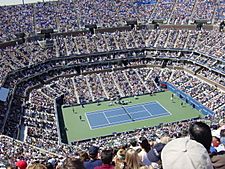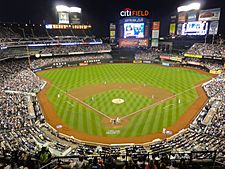Culture of New York City facts for kids
New York City is often called the cultural capital of the world. The city's culture is huge and diverse, with people from all over the globe. Did you know that over 800 languages are spoken here? That makes New York the most linguistically diverse city on Earth!
Many important American cultural movements started in New York. For example, the city was a major hub for modern dance and stand-up comedy in the early 1900s. In the 1940s, it was the top spot for jazz music. Later, in the 1950s, expressionism in art became popular. New York is also the birthplace of hip hop, punk rock, and the Beat Generation literary movement.
The Stonewall Inn in Greenwich Village is a very important landmark. It's where the Stonewall riots happened in June 1969. These events are seen as the start of the modern gay rights movement.
New York is also where the Harlem Renaissance began, which was a huge movement in African-American literature and art. In painting, abstract expressionism (also known as the New York School) started here. For music, New York gave us hip hop, punk, salsa, freestyle, Tin Pan Alley, and certain kinds of jazz. It even helped develop disco music, along with Philadelphia.
The city is a global leader in fashion, hosting New York Fashion Week, a major event that gets a lot of media attention. Artists are drawn to New York because the city government invests more money in the arts than the national government does. New York is also a main center for buying and selling art around the world.
Contents
New York City's Fast Pace
One thing people often say about New York is how fast-paced it is. This led to the saying "wikt:New York minute", meaning a very short amount of time. Journalist Walt Whitman once described New York's streets as filled with "hurrying, feverish, electric crowds." Everyone seems to be moving quickly!
Supporting the Arts in New York
The New York City Department of Cultural Affairs (DCLA) is a part of the city government. It's the biggest public funder of the arts in the United States. The DCLA's budget for arts is even larger than the National Endowment for the Arts, which is the federal government's main arts funding group.
The DCLA helps about 1,400 art and cultural groups across New York's five boroughs. This includes 375 museums, 96 orchestras, 24 performing arts centers, 7 botanical gardens, 5 zoos, and 1 aquarium. They support all kinds of arts, from visual art to music, literature, and performing arts. They also help science and history places like zoos and gardens. The DCLA also has a "Percent for Art" program. This program sets aside money from building projects to create public art.
Arts and Culture in NYC
New York City is a hub for many types of art.
Music in New York
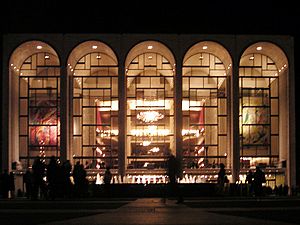
New York became a major center for the American music industry in the early 1900s. This was thanks to Broadway musicals and the songwriters of Tin Pan Alley. Since then, the city has been important for many different music styles.
New York has been a center for classical music since the 1800s. The New York Philharmonic, started in 1842, helped build the city's musical fame. George Gershwin is the most famous New York composer. His music mixed styles like jazz, ragtime, and Broadway songs. His work made American classical music famous around the world. Later, Aaron Copland from Brooklyn used American folk music and jazz in his pieces.
The New York blues style had strong jazz influences and a modern, city feel. Musicians like Lionel Hampton were important in this area. In New York, jazz mixed with stride (an advanced form of ragtime) and grew even more. Fletcher Henderson's jazz orchestra, starting in 1923, helped create swing music. This swing style was catchy and great for dancing. Later, singers like Billie Holiday and Ella Fitzgerald became stars.
In the 1940s, New York became a center for American folk music. Greenwich Village in Lower Manhattan was a popular spot for folk music and political action. Artists like Pete Seeger and Joan Baez were part of this scene. In the early 1960s, Joan Baez helped introduce Bob Dylan to a wider audience. Dylan quickly became famous, blending folk and rock music. By the mid-1960s, many bands and singer-songwriters emerged. The album The Velvet Underground & Nico (1967) was very influential.
Disco music grew from funk, soul, and jazz in the 1960s. It became a distinct genre with strong synthesizers and a steady beat. Many major disco clubs were in New York, like Paradise Garage and Studio 54. These clubs attracted famous artists, fashion designers, and intellectuals.
In the 1970s, punk rock started in New York's downtown music scene. Bands like the New York Dolls, Ramones, and Patti Smith were key. This scene also led to "new wave" rock at clubs like CBGB's. The 1970s also saw the growth of Salsa and Latin jazz. Artists like Tito Puente and Celia Cruz helped spread this music worldwide.
Hip hop began in the Bronx in the early 1970s. DJs like DJ Kool Herc started isolating drum beats from funk songs and rapping over them. For many years, New York was the main city for hip hop. Artists like Kurtis Blow and LL Cool J brought hip hop to the mainstream. Later, East Coast rap was defined by groups like Run-D.M.C. and artists like Nas and Jay-Z.
New York is one of only five U.S. cities with permanent professional companies in all major performing arts. These include The Metropolitan Opera, New York Philharmonic, New York City Ballet, and the Public Theater. The Lincoln Center for the Performing Arts is the world's largest arts institution. It has 12 different companies and is home to Jazz at Lincoln Center. Other famous venues include Carnegie Hall and Radio City Music Hall.
New York's subway system is also a big stage for musicians. Each week, over 100 musicians perform in the subway, playing everything from classical to jazz music.
Visual Art in New York
The 1913 Armory Show in New York brought European modern art to the U.S. This exhibition changed American art, showing artists that art was about expression, not just realism. It encouraged American artists to find their own unique voice. Photographers like Alfred Stieglitz and painters like Charles Demuth helped create an American style in fine arts. The Museum of Modern Art, founded in 1929, became a showcase for modern art. After World War II, New York became the world's center for contemporary fine art.
After World War II, the New York School of artists created the first truly original American painting style: abstract expressionism. Leaders like Jackson Pollock and Willem de Kooning focused on instinctual arrangements of color and space. They showed the effects of the physical act of painting on the canvas.
New York's art scene in the 1950s and 1960s also defined the American pop art movement. Artists like Andy Warhol, Larry Rivers, and Roy Lichtenstein used everyday objects and images from popular culture, like Coca-Cola bottles and comic strips, in their art.
Today, New York is a global center for the art market. The Upper East Side has many art galleries. The Chelsea neighborhood is known for its more than 200 modern art galleries. DUMBO in Brooklyn is also a growing art area. Money from Wall Street and wealthy donors flows into the art market, often helping artists become famous.
Alongside the mainstream art, there are always underground movements. Hip hop art and graffiti are examples, with artists like Keith Haring and Jean-Michel Basquiat. These movements add visual energy to the city. Long Island City, Queens, is also becoming a major art scene, with many studios and galleries in its old warehouses.
Public Art in NYC
New York City has a law that sets aside money for art in public buildings. For city-owned building projects, at least 1% of the first $20 million, and then 0.5% of amounts over $20 million, must be used for artwork. The most that can be spent on art for one site is $400,000.
Many famous artists have created public art in the city. In 2005, Christo and Jeanne-Claude created The Gates in Central Park. This project had 7,503 metal "gates" with saffron-colored fabric flags along 23 miles of pathways.
The subway system also has public art, like detailed tile mosaics and station signs. Graffiti art also became popular in New York. By 1970, New York was the center of graffiti innovation. The "Zoo York" style came from a subway tunnel under the Central Park Zoo. This tunnel was a meeting spot for early graffiti artists. However, with more law enforcement and cleaning of subway trains, graffiti on the subway faded in the 1980s and 1990s.
Film in New York
New York's film industry is the second largest in the United States, after Hollywood. It brings billions of dollars to the city's economy. In the early days of film, New York was a major filmmaking center. But Hollywood, with its better year-round weather, eventually became the main home for American cinema. The Kaufman-Astoria film studio in Queens, built during the silent film era, was used by famous comedians like the Marx Brothers. When filmmaking moved west, much of New York's film setup was used for the growing television industry.
New York's film industry has seen a comeback. In 2006, 276 films were made in the city. More than a third of professional actors in the United States live in New York.
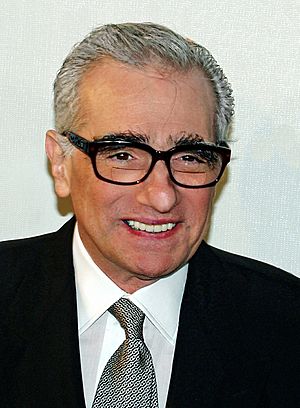
Filmmakers like Woody Allen, known for movies like Manhattan, are strongly linked to New York. Actor Robert De Niro started the Tribeca Film Festival after the September 11, 2001 events. Other famous New York directors include Martin Scorsese and Spike Lee.
While big studio movies are often made in Hollywood, New York is a capital for independent films. The city hosts important film festivals like the Tribeca Film Festival and the New York Film Festival. It's also home to independent film companies like Miramax Films. The Anthology Film Archives in New York preserves and shows many experimental films from history.
New York also has public-access television channels, like the Manhattan Neighborhood Network. These channels show local programs, from jazz music to discussions about local issues. The city's own broadcast service, NYC Media, creates award-winning shows about New York City life and government.
Stage Performance in New York
Dance in New York
The early 1900s saw the rise of modern dance in New York. Martha Graham, a famous modern dancer, created many popular works with New York composers. Merce Cunningham introduced new ideas like "chance procedures" and "pure movement" to dance. George Balanchine helped connect classical ballet with modern styles.
New York has also been a center for African-American modern dance. Alvin Ailey founded the Alvin Ailey American Dance Theater in 1958. His dances were inspired by his memories of Texas, the blues, and gospel music. Pearl Primus was another important African-American dancer, known for her powerful social-protest dances.
New York was also the birthplace of other dance forms. Breakdance started in the African-American and Puerto Rican communities of the South Bronx in the early 1970s. It became a popular street dance as part of the Hip Hop Movement. Breakdancing battles were even used by rival gangs to settle disagreements peacefully.
Tap Dance, an American art form, first appeared in New York's Five Points District.
Theatre in New York
With electric lighting, theatre productions became more elaborate. In the 1880s, New York theaters on Broadway began to show a new type of stage show: the Broadway musical. These musicals often told stories of hope and ambition, influenced by the many immigrants in the city.
Many New York musicals became famous national events. One example is The Cradle Will Rock (1937), a labor union opera. When the show was almost shut down, the cast performed it from their seats in the audience, making it a legendary event. Playwrights like Arthur Miller became icons in American theater.
Yiddish theatre, performed in Yiddish, was a major cultural influence in New York. It started in 1882 with a group led by Boris Thomashefsky. These plays often reflected the lives of Jewish immigrants. Some performers, like Bertha Kalich, even moved between Yiddish theatre and Broadway.
Vaudeville was another popular multi-act theatre style from the 1880s to the 1920s. A vaudeville show could include acrobats, singers, animal acts, and more. Tony Pastor created the first "clean" vaudeville show in New York in 1881 to attract women. The Palace Theatre on Broadway was a top venue for vaudeville.
Today, the 39 largest theaters in New York are known as "Broadway". They are mostly located near Times Square. Broadway shows, like Cats and The Phantom of the Opera, are world-famous. Broadway theaters, along with London's West End, are considered the most professional in the English language.
Smaller theaters, called off Broadway and off-off-Broadway, can put on more experimental shows for smaller audiences. New York is a center for experimental theatre groups.
New York's subways also host performances. The "Ms Subways" contest, where women were chosen to represent the subway, ran for many years. There have even been full plays performed on subway trains!
Stand-up Comedy in New York
Many people consider New York to be the heart of stand-up comedy in the United States. The city is home to many leading comedy clubs, including Caroline's.
Literature in New York
Novels and Literary Movements
Several important literary movements started in New York. Washington Irving, one of the first American writers to be praised in Europe, was a New Yorker. His History of New York (1809) made "Knickerbocker" a term for old-fashioned Dutch New Yorkers. This term later inspired the name of the New York Knicks basketball team.

The Harlem Renaissance created the African-American literary tradition in the U.S. This "flowering of Negro literature" happened between 1924 and the Wall Street Crash of 1929. African-Americans from the Great Migration and immigrants from Africa and the Caribbean gathered in Harlem. Harlem became the most famous center of Black life in the U.S. at that time. Black writers in Harlem challenged racism and often promoted racial integration. Their work included different styles, from celebrating Pan-Africanism to using new experimental forms like jazz poetry.
In the mid-20th century, a group called The New York Intellectuals emerged. These American writers and critics supported leftist political ideas and tried to combine literary theory with Marxism. Many of them studied at the City College of New York. Writers like Mary McCarthy and Irving Howe were part of this group. Ayn Rand, whose novels The Fountainhead and Atlas Shrugged were set in New York, also lived in the city for many years.
Alongside these mainstream groups, New York has had underground literary movements. The Beat Generation poets and writers, including Allen Ginsberg and Jack Kerouac, were centered in New York. This tradition continued with writers like Kathy Acker. These movements often involved independent publishers and small literary magazines.
Many literary organizations have grown in the city, including PEN America. This group defends free speech and promotes literature. Literary journals like The Paris Review and The New York Review of Books are also important to the city's literary scene.
Many modern writers live in New York, especially in the Park Slope neighborhood of Brooklyn. These include Norman Mailer, Don DeLillo, and Jonathan Lethem. New York has also been a thriving place for Jewish American literature. It's also home to Puerto Rican poets and writers, known as "nuyoricans." The famous Nuyorican Poets Café is a center for the Nuyorican Movement.
New York City doesn't have an official poet laureate. Instead, it hosts an annual "People's Poetry Gathering." Here, ordinary New Yorkers add their own lines to a long poem about the city. This idea was also used after the September 11, 2001 attacks. Poems were printed on tall banners as a tribute to the destroyed World Trade Center towers.
Comic Books in New York
The American comic book was invented in New York in the early 1930s. It was a way to cheaply reprint and sell newspaper comic strips, which also grew in New York papers. Immigrant culture in the city was a main topic for early comics. Almost all early comic book creators and workers, from publishers to artists, were based in New York. Many came from immigrant Jewish families in the Lower East Side and Brooklyn.
Superheroes, a unique American contribution to comic books, likely started in New York. Even if not directly set in New York, superhero stories often use cities that look like it, such as Metropolis or Gotham City (Gotham is a common nickname for New York).
Marvel Comics became famous for setting their stories in a "real" New York. They gave recognizable addresses for their characters' homes. For example, Spider-Man's alter ego, Peter Parker, lived in Forest Hills, Queens. The Baxter Building, home of the Fantastic Four, was at 42nd and Madison Avenue. In 2007, New York City even declared "Spider-Man Week" to celebrate the release of Spider-Man 3.
New York also inspired and hosted many non-superhero comic books. Cartoonist Will Eisner often showed everyday life among poor, working-class, and immigrant New Yorkers. Today, New York's alternative comics scene is strong, with artists like Art Spiegelman.
Museums in New York
The Metropolitan Museum of Art is one of the world's largest and most important art museums. It's located on the east side of Central Park. It also includes "The Cloisters," a complex of buildings with medieval art. The Museum of Modern Art (MoMA) is another major art museum. The Brooklyn Museum is the second largest art museum in New York, with over 1.5 million objects, from ancient Egyptian art to contemporary pieces.
There are many smaller, important galleries and art museums. The Frick Collection is a top small art museum, with high-quality old master paintings in the former home of Henry Clay Frick.
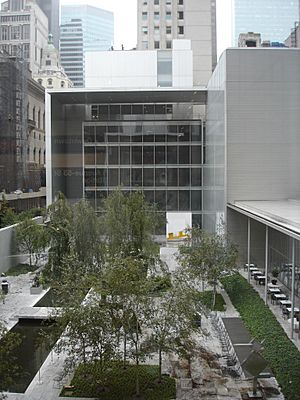

The Jewish Museum of New York was founded in 1904. It has a collection of 28,000 objects important to Jewish history and culture.
El Museo del Barrio was started in 1969 by Puerto Rican artists and leaders. It's located in Spanish Harlem. The museum originally served Puerto Ricans, but its scope is growing with New York's large Latino population.
The American Museum of Natural History and its Hayden Planetarium focus on science. There are also many special museums, like the Cooper-Hewitt, National Design Museum for design, and the Museum of Television and Radio. You can even visit the Museum of the City of New York. Many of the city's museums are along the Museum Mile section of Fifth Avenue.
In recent years, New York's cultural institutions have seen a lot of new building and renovation. Long Island City in Queens is a growing art area, home to places like P.S.1 Contemporary Art Center. SculptureCenter, New York's only non-profit space for contemporary sculpture, moved to Long Island City in 2002.
Between 2006 and 2010, the New York City Department of Cultural Affairs had its largest budget ever for building projects: $865 million. This investment has created many jobs and boosted the city's economy.
New York City Inventions
New York City has been the birthplace of several unique inventions:
Cultural Diversity in New York
| Select Holy Days Officially Observed in New York City | ||
| Holy Day | Culture | Month (2006) |
| Eid al-Adha | Muslim | January |
| Asian Lunar New Year | East Asia | January |
| Ash Wednesday | Christian | March |
| Purim | Jewish | March |
| Nowruz | Iranian | March |
| Passover | Jewish | April |
| Good Friday | Christian | April |
| Shavuot | Jewish | June |
| Feast of Assumption | Catholic | August |
| Rosh Hashanah | Jewish | September |
| Yom Kippur | Jewish | September |
| Succoth | Jewish | October |
| Diwali | Hindu | October |
| Eid ul-Fitr | Muslim | October |
| All Saints' Day | Catholic | November |
| Eid al-Adha | Muslim | December |
New York is often seen as an international city because of its large immigrant population. But for many, this openness to newcomers makes it the perfect example of a "nation of immigrants." The term "melting pot" comes from a 1908 play called The Melting Pot, set in the Lower East Side. This area was where many immigrants from different European countries learned to live together. In 2000, 36% of the city's population was born in another country. Unlike other cities where immigrants might come from just a few countries, New York has people from all over the world. The top seven countries of origin are the Dominican Republic, China, Jamaica, Russia, Italy, Poland, and India.
New York's cultural diversity can be seen in its official city holidays. For example, Diwali, the Hindu Festival of Lights, was recently added to the calendar due to the growing South Asian community.
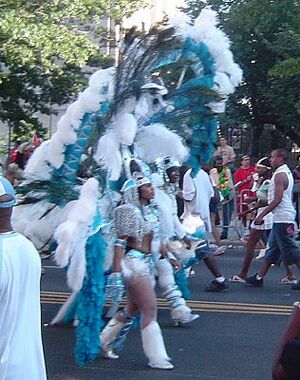
Immigrants in New York often live in neighborhoods where they can connect with people from their home country. The city has many distinct communities of people from Indians, Irish, Italians, Chinese, Koreans, Dominicans, Puerto Ricans, Caribbeans, Hasidic Jews, Latin Americas, and Russians.
Many of the city's largest annual events are parades celebrating these ethnic communities. City leaders often attend these parades. They include the St Patrick's Day Parade, the Puerto Rican Day Parade (which draws up to 3 million people), and the West Indian Labor Day Parade. New Yorkers from all backgrounds enjoy these events. Other popular parades include the Gay Pride Parade, the Greenwich Village Halloween Parade, and the Coney Island Mermaid Parade.
New York has more Jewish people than any other city in the world, even more than Jerusalem. About one million New Yorkers, or 13%, are Jewish. Because of this, New York culture has adopted some Jewish elements, like bagels. The city is home to many important Jewish organizations and synagogues, including Temple Emanu-El, the largest Jewish house of worship in the world.
Festivals and Parades
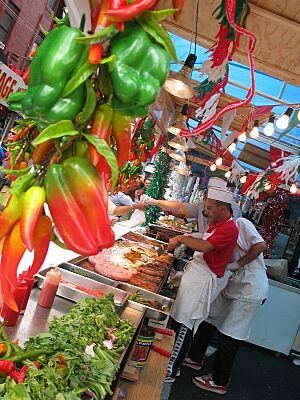
New York, with its many communities, has a huge number of parades and street festivals. SummerStage in Central Park offers about 1,200 free concerts, dance, theater, and spoken word events each year.
The Village Halloween Parade is an annual event on Halloween night in Greenwich Village. It stretches over a mile and draws two million spectators. Fifty thousand people in costumes, dancers, artists, and performers join in.
The Feast of San Gennaro is an 11-day street fair in mid-September in Manhattan's Little Italy. The festival has parades, street vendors selling sausages and zeppole, games, and a religious procession. Another similar festival is held in the Bronx's Little Italy.
Other major parades include the annual Macy's Thanksgiving Day Parade, which features huge inflatable balloons. The Puerto Rican Day Parade is held along Fifth Avenue (Manhattan).
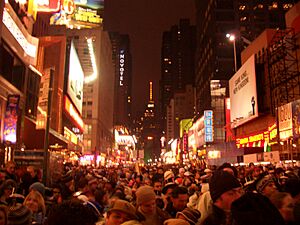
A big part of New Year's Eve celebrations in the U.S. is the "ball dropping" on top of One Times Square. A large Waterford Crystal ball is lowered, reaching the bottom at midnight. From 1982 to 1988, New York dropped a large apple to honor its nickname, "The Big Apple." For decades, the bandleader Guy Lombardo and his Royal Canadians played Auld Lang Syne as the first song of the new year in Times Square.
Sports in New York
New York City is home to the headquarters of major sports leagues like the National Football League, Major League Baseball, and the National Basketball Association. The New York area has the most professional sports teams in these leagues. Five of the ten most expensive stadiums ever built are in the New York area.
New York is often called the "Capital of Baseball." New York teams have won 35 World Series championships. It's one of only five major metro areas with two major league baseball teams. There have been 14 World Series where two New York teams played each other, known as the Subway Series. The most recent was in 2000.
The city's current MLB teams are the New York Mets and the New York Yankees. The Yankees have won a record 27 championships, and the Mets have won twice. New York was also once home to the Brooklyn Dodgers and the New York Giants, who both moved to California in 1958. There are also two Minor League Baseball teams in the city.
The city has two NFL teams, the New York Giants and the New York Jets. Both teams play their home games in nearby New Jersey.
The New York Rangers represent the city in the NHL. The New York Islanders also play in the New York area.
The city's NBA teams are the Brooklyn Nets and the New York Knicks. The Women's National Basketball Association team is the New York Liberty. The first national college basketball championship was held in New York in 1938.
In soccer, New York City FC plays at Yankee Stadium. The New York Red Bulls play in nearby New Jersey. Historically, the city was known for the New York Cosmos, a very successful team that featured Pelé, one of the world's most famous soccer players.
Queens hosts the U.S. Open Tennis Championships, one of the four annual Grand Slam tennis tournaments. The New York City Marathon is one of the world's largest marathons. Boxing is also popular, with events like the Amateur Boxing Golden Gloves held at Madison Square Garden.
Many sports are linked to New York's immigrant communities. Stickball, a street version of baseball, became popular with young people in the 1930s. A street in the Bronx has even been renamed Stickball Boulevard to honor this sport.
New York in Popular Culture
Because of its size and influence, New York has been shown in many different ways in movies and TV. From the sophisticated city in Woody Allen films to the chaotic urban jungle in movies like Martin Scorsese's Taxi Driver, New York has been the setting for almost every idea about big city life.
In early films, New York was seen as elegant and worldly. But during the city's tough times in the 1970s and early 1980s, movies like The French Connection and Death Wish showed New York as full of crime and violence. As the city improved in the 1980s and 1990s, TV shows like Friends, Seinfeld, and Sex and the City showed city life as glamorous and exciting. However, many crime dramas, like Law & Order, still focus on crime in the city, even though New York has become one of the safest large cities in the U.S. in recent years.


